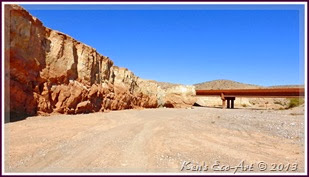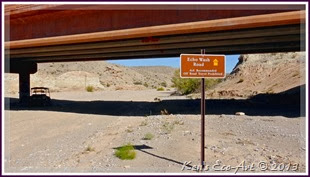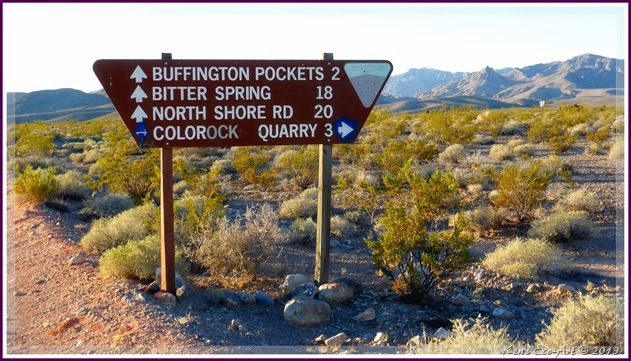 |
| (Fig. 01) |
|
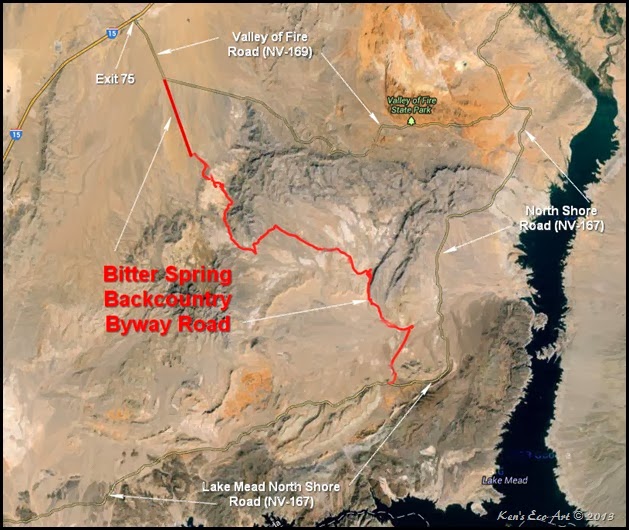 |
| (Fig. 02) |
|
Directions: From the Stratosphere, turn right onto Las Vegas Blvd south. Go a little over a mile and turn right again onto W. Sahara Ave. Go 1.2 miles and reverse direction by making a U-Turn to head back east on W. Sahara Ave. Go .5 miles and turn left to merge onto I-15 N via the ramp on the left toward Salt Lake City. Travel about 35 miles and take Exit 75 toward Valley of Fire/Lake Mead. Turn slight right onto NV-169/Valley of Fire Road/Valley of Fire Hwy. There is a Paiute Indian Reservation Tobacco Shop and small casino at that exit. It is a great place to make a pit stop before continuing on. Approximately 3 miles from the I-15 Exit 75, the northern end of this road cuts off of the Valley of Fire Road (NV-169) and heads south (Fig. 02). This is the beginning of Bitter Spring Backcountry Byway Road (Fig. 03). The road only remains paved for a short distance, then becomes graded dirt. From this point it runs southeast for approximately 20 miles until it reaches the Lake Mead North Shore Road (NV-167), though you probably won’t be able to travel much more than five miles without a high clearance, four-wheel drive vehicle.
Road Description: Depending upon where you look, I have seen this road referred to as Bitter Spring Road, Bittersprings Road, Bitterspring Trail, Buffington Pockets Road and Bitter Spring Backcountry Byway Road. Because it is such a little used track, I have chosen the latter title when referring to this road on all of my pages. It is a narrow, rough, four-wheel drive road that runs through a lonely, barren section of the rugged Muddy Mountains, traveling across wide plains, through narrow canyons and washes, and past old mining operations, forming much of the northern and eastern boundary of the Muddy Mountain Wilderness Study Area. After skirting the Buffington Pockets, it climbs up a ridge that overlooks Hidden Valley. It then descends down and runs across an area known as White Basin, just two miles north of Bitter Ridge. After crossing this basin it follows a wash along West Longwell Ridge before skirting the southern tip of East Longwell Ridge on the northern edge of Bitter Spring Valley. About a mile or so later it reaches Bitter Spring and then becomes Echo Wash which leads all the way to Lake Mead's Echo Bay. A four-wheel drive, high-clearance vehicle is necessary to follow the byway's entire length. It is often known and referred to by the unique areas that it either provides access to or passes through, such as Colorock Quarry, the Buffington Pockets, Hidden Valley, White Basin, the American Borax Mine and Bitter Spring. Below, you will find brief descriptions of these areas with links to separate pages containing pictures and more detailed information when available.
|
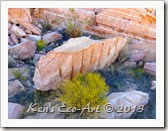 Colorock Quarry: Just four miles after entering Bitter Spring Backcountry Byway Road there is a side road that leads to Colorock Quarry. This three mile road runs into an area full of multi-hued colorful layers of Aztec Sandstone, some of which have been quarried for decorative rock. Click here for pictures and more information … Colorock Quarry. Colorock Quarry: Just four miles after entering Bitter Spring Backcountry Byway Road there is a side road that leads to Colorock Quarry. This three mile road runs into an area full of multi-hued colorful layers of Aztec Sandstone, some of which have been quarried for decorative rock. Click here for pictures and more information … Colorock Quarry.
|
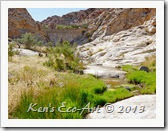 Buffington Pockets: The Buffington Pockets feature many of the same sandstone formations found in the Valley of Fire. The colorful layers and surprising textures and forms are found in the outcroppings of Aztec Sandstone, This slick-rock country includes white domes, and red, orange, purple and white "rainbow"-layered rock that are in sharp contrast to the towering dark gray cliffs to the east. Click here for pictures and more information … Buffington Pockets. Buffington Pockets: The Buffington Pockets feature many of the same sandstone formations found in the Valley of Fire. The colorful layers and surprising textures and forms are found in the outcroppings of Aztec Sandstone, This slick-rock country includes white domes, and red, orange, purple and white "rainbow"-layered rock that are in sharp contrast to the towering dark gray cliffs to the east. Click here for pictures and more information … Buffington Pockets.
|
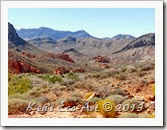 Hidden Valley: Just past the Buffington Pockets, Bitter Spring Backcountry Byway Road circles around an area knows as Hidden Valley. A hiking route from the Colorock Quarry camping area winds through sandstone crags and up a long, steep hillside to a rocky outcrop on a saddle overlooking Hidden Valley. With the right lighting, the view into Hidden Valley with Muddy Peak towering above can be stunning -- both grand and sublime, and is one of the best views in all of southern Nevada. From the overlook, a use-trail continues down to the floor of Hidden Valley. Click here for more pictures and information ... Hidden Valley. Hidden Valley: Just past the Buffington Pockets, Bitter Spring Backcountry Byway Road circles around an area knows as Hidden Valley. A hiking route from the Colorock Quarry camping area winds through sandstone crags and up a long, steep hillside to a rocky outcrop on a saddle overlooking Hidden Valley. With the right lighting, the view into Hidden Valley with Muddy Peak towering above can be stunning -- both grand and sublime, and is one of the best views in all of southern Nevada. From the overlook, a use-trail continues down to the floor of Hidden Valley. Click here for more pictures and information ... Hidden Valley.
|
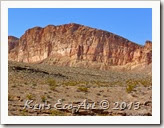 White Basin: Traveling around a high spur of the Muddy Mountains, the road drops into White Basin. To the south looms Muddy Peak, high point of the range. The trail follows dry graveled washes eastward to the remains of the American Borax Mine. Alongside mine tailings lie the mill's foundation, building remnants, thirty-foot-deep water cisterns, mine tunnels, and adits carved into the hillsides. I hope to get more pictures here the next time I visit this area. White Basin: Traveling around a high spur of the Muddy Mountains, the road drops into White Basin. To the south looms Muddy Peak, high point of the range. The trail follows dry graveled washes eastward to the remains of the American Borax Mine. Alongside mine tailings lie the mill's foundation, building remnants, thirty-foot-deep water cisterns, mine tunnels, and adits carved into the hillsides. I hope to get more pictures here the next time I visit this area.
|
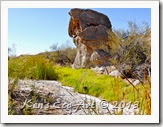 Bitter Spring: The last main point of interest on the southeastern end of the road is Bitter Spring. This stretch of running water is located along the north side of the wash road. Its water seeps out of the ground among thick stands of feathery tamarisk, before disappearing again in the sandy creek bed. Click here for more pictures and information ... Bitter Spring. Bitter Spring: The last main point of interest on the southeastern end of the road is Bitter Spring. This stretch of running water is located along the north side of the wash road. Its water seeps out of the ground among thick stands of feathery tamarisk, before disappearing again in the sandy creek bed. Click here for more pictures and information ... Bitter Spring. |
 |
09/12/2015 Trip Notes: For this trip, myself and two other friends (Jim Herring (top right) and Marc Resnic (bottom) of picture (Fig. 04) rented a 4WD jeep for this journey. We decided to visit the old marble quarry at the end of Colorock Road before heading to Bitter Spring and the end of the road. Our first disappointment of the day was that and area of the road was washed out about a 1/4 mile before reaching the quarry and the old marble house. Because we decided that it was too hot to hike to it and back, we decided to turn around and drive back to the Bitter Spring Country Byway road. For pictures and info on the quarry from a previous trip, click here ... Colorock Quarry.
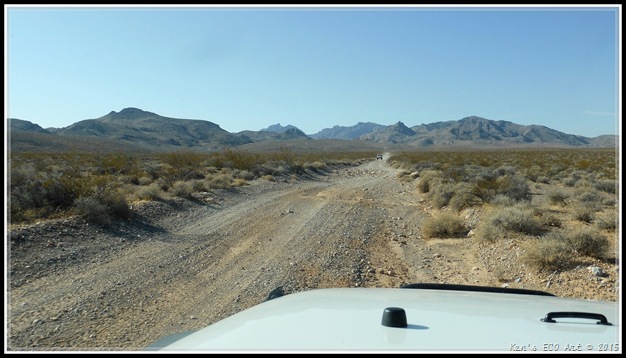 |
| (Fig. 03) |
|
Upon our approach to the Buffington Pockets area and the old CCC dam, It became quite evident that this road, as was Colorock Road, were both much worse than they were on my last visit. In addition, upon reaching the dam it was evident that this area hasn't had much rain for quite some time. Nothing was green, everything war parched and bone dry. There was not one sign of water in any of the “pockets”, or anywhere; the grasses were totally parched brown. Compare this picture (Fig. 04) to the picture from my previous trip in (Fig. 24) below. Click here for additional pictures and more information on the Buffington Pockets. We then continued to drive up the road to the highest point in the area, where there are some gorgeous orange Aztec sandstone outcrops (Figs. 05 & 06). As we rounded the orange outcrop in (Fig. 06), we spotted two desert bighorn sheep climbing their way to the top (Figs. 07 & 08). To better see them, click the pictures to enlarge. As we began to decent down into the big wash that crosses the lower valley area we spotted two wild horses (Fig. 09). Following the wash-road southeast across the desert on our way to the bitter spring (middle of the map in Fig. 02), we were presented some quite beautiful scenes and geology (Figs. 10 thru 14). Once we reached the lush, green Bitter Spring (Fig. 15 & 16) we spent a half and hour walking the spring area before we decided to have lunch. We spotted some roadrunners sipping water under a large tree (Figs 17 & 18). We even found a wild horse eating in the grasses along the edge of the spring area (Fig. 19 & 20). For some additional pictures to the Bitter Spring page. About a quarter mile past the spring on our way to the Lake Mead Northshore Road (Fig. 32), we startled two coyotes in the wash who quickly scrambled up the side of a high ridge (Figs. 21 thru 23). For more pictures and info ... Coyotes vs Wolves or Foxes. Stopping for pictures, hiking, water breaks, lunch, etc. this trip took up about 3.5 hours. In addition to the scenery, the spottings of wildlife were an added benefit.
|
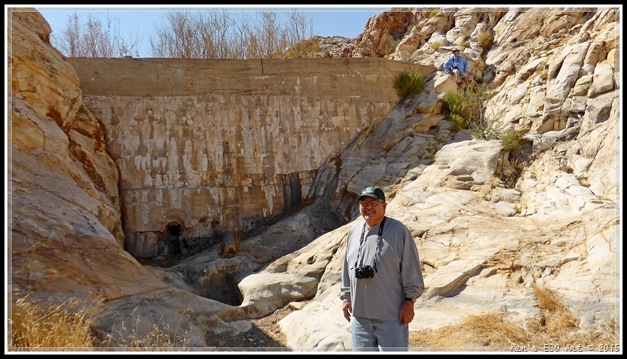 |
| (Fig. 04) |
|
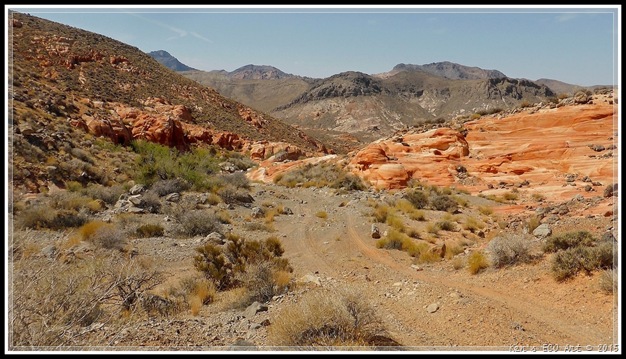 |
| (Fig. 05) |
|
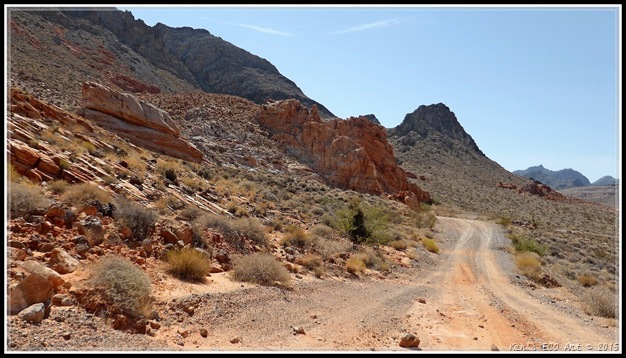 |
| (Fig. 06) |
|
 |
| (Fig. 07 |
|
 |
| (Fig. 08 |
|
|
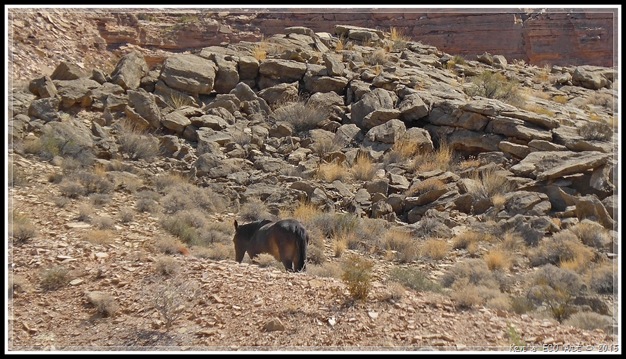 |
| (Fig. 09) |
|
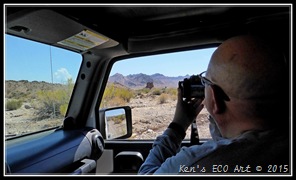 |
| (Fig. 10) |
|
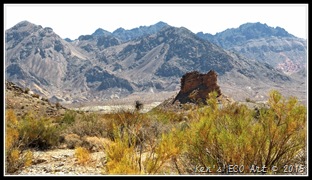 |
| (Fig. 11) |
|
|
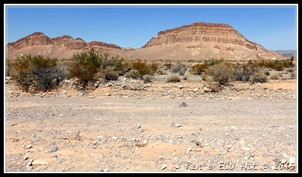 |
| (Fig. 12) |
|
 |
| (Fig. 13) |
|
|
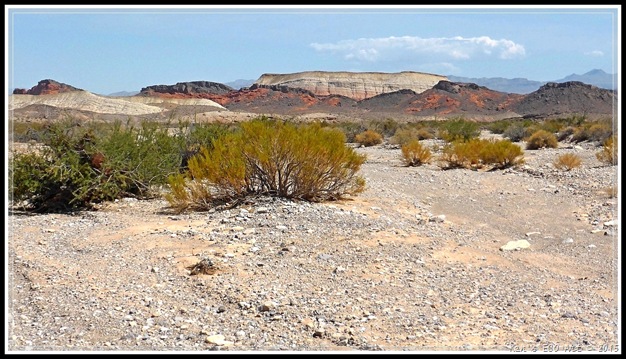 |
| (Fig. 14) |
|
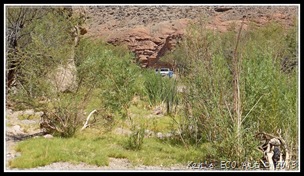 |
| (Fig. 15) |
|
 |
| (Fig. 16) |
|
|
 |
| (Fig. 17) |
|
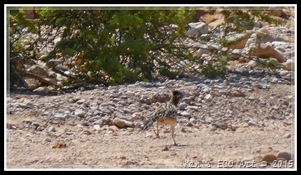 |
| (Fig. 18) |
|
|
 |
| (Fig. 19) |
|
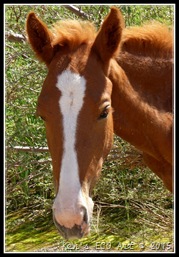 |
| (Fig. 20) |
|
|
 |
| (Fig. 21`) |
|
 |
| (Fig. 22) |
|
|
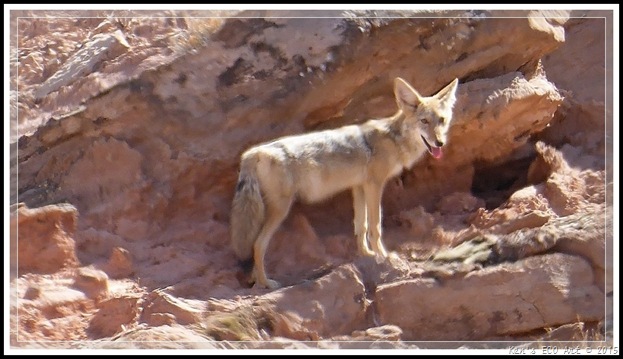 |
| (Fig. 23) |
|
|
|
|
|

10/22/2013 Trip Notes: Just another beautiful sunny fall day, Harvey and I decided to take the Ranger out to Bitter Spring Backcountry Byway Road and travel its entire length, from Valley of Fire Road down to Lake Mead’s North Shore Drive. Before heading out for the twenty plus mile drive across the Muddy Mountain Range, we decided to take the side road that leads to Colorock Quarry. Click here for pictures and a description of this drive … Colorock Quarry. After visiting this area we got back on Bitter Springs Road and headed to the Buffington Pockets area. Because we had both hiked this area before, we didn't spend a lot of time here, though we did stop and take the time to hike up to the top of the dam (Fig. 24). Click here to see the update I made to my original page on the … Buffington Pockets. As we continued to drive up the road, around and beyond the areas we hiked on previous visits, we eventually came to a ridge that contained some gorgeous sandstone outcrops (Fig. 25) and views overlooking Hidden Valley. Click the following link for more pictures of this area … Hidden Valley. The further we traveled, the more the road descended into a deep wash (Figs. 26 & 27).
|
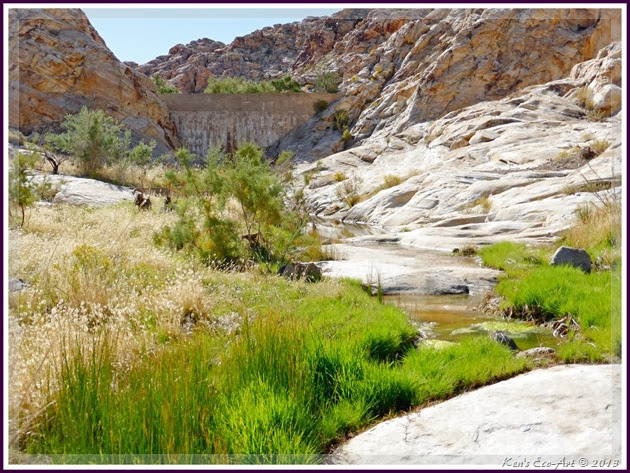 |
| (Fig. 24) |
|
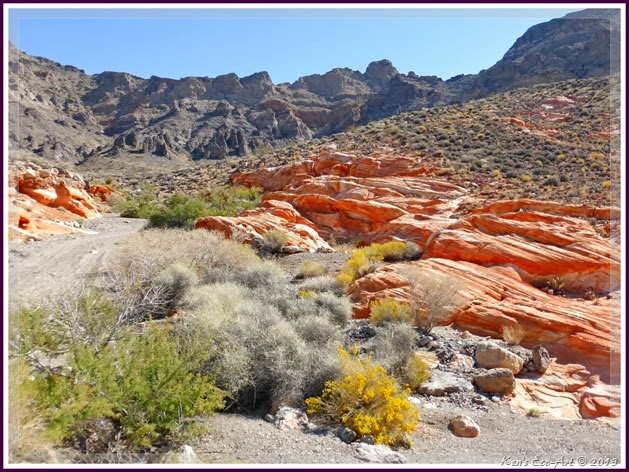 |
| (Fig. 25) |
|
|
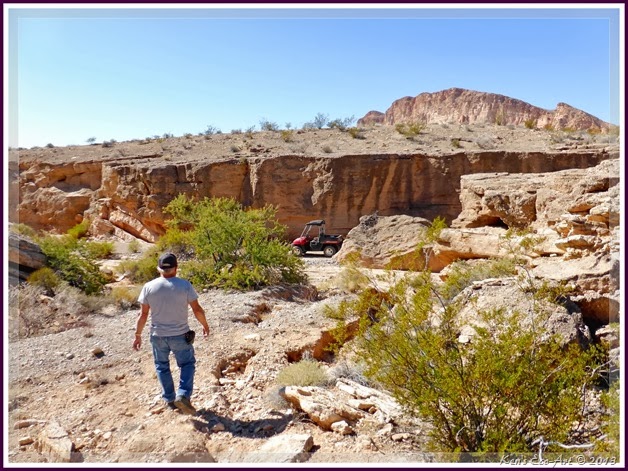 |
| (Fig. 26) |
|
 |
| (Fig. 27) |
|
While driving through this deep wash area, we actually came upon a lynx (bobcat) that was running down the wash road in front of us. Before we could get our cameras out for a full-on picture he ran up a side-wash and up its conglomerate side into a small crevice (Fig. 27), where upon he turned and peered out at us. The arrow in (Fig. 27) points to where he went. (Click the picture to enlarge) Because he was so far away from us at this point, it was extremely difficult to get a good picture. The picture in (Fig. 28) below was taken at the 480mm setting on my lens. As we began to climb out of the deep wash, we began to see some of the colorful landscapes that surrounded us (Figs. 29 & 30). At a distance of about 18 miles out, we came upon the area known as Bitter Spring (Fig. 31). Click here for more pictures of this area … Bitter Spring. At about the 20-mile mark we came to North Shore Drive (Fig. 32) and the end of Bitter Springs Road. Here the road enters into the Lake Mead National Recreation Area and turns into Echo Bay Road (Fig. 33). Unfortunately, a sign indicated that you had to have a registered vehicle to go beyond this point and we were unable to take this road down to Lake Mead. As it was getting late in the afternoon, it was now time to take the two hour journey back to our starting point. This turned out to be a great ride with lots of colorful scenery. Unfortunately, we were not left with enough time to explore some of the many ‘side-roads’ that we had passed on the way down. Guess we will have to save them for another day.
|
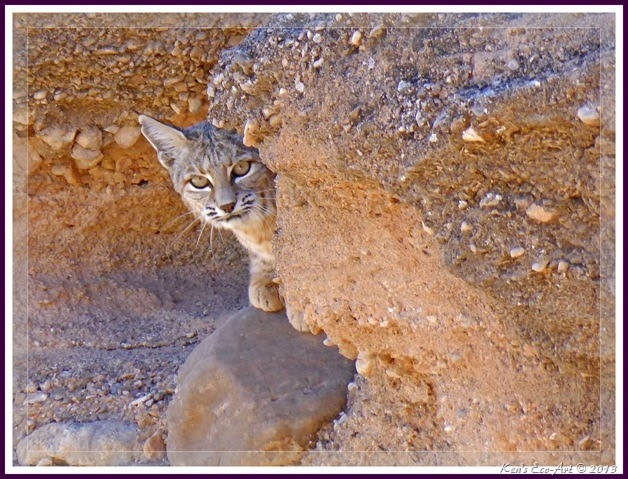 |
| (Fig. 28) |
|
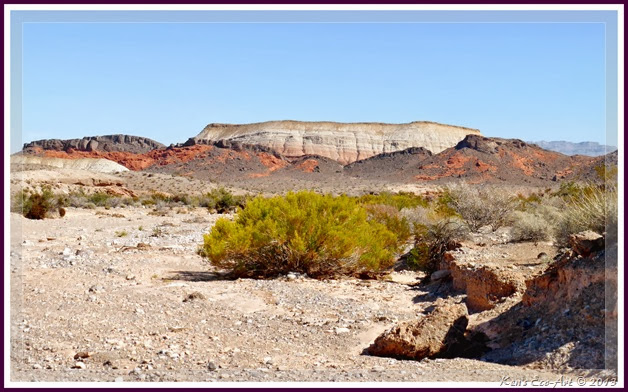 |
| (Fig. 29) |
|
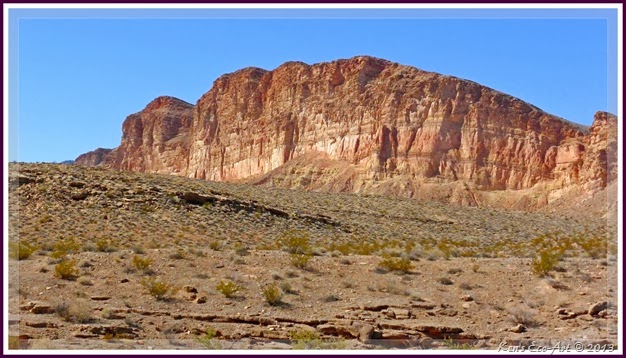 |
| (Fig. 30) |
|
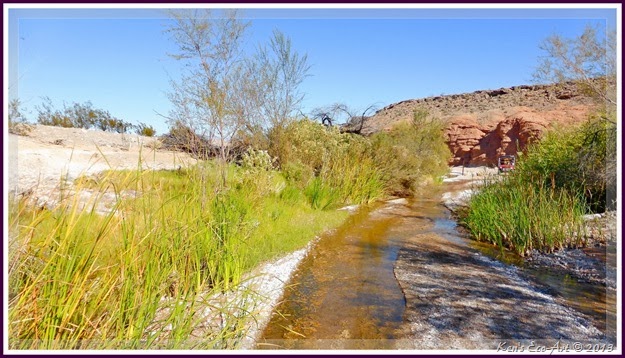 |
| (Fig. 31) |
|
 Colorock Quarry: Just four miles after entering Bitter Spring Backcountry Byway Road there is a side road that leads to Colorock Quarry. This three mile road runs into an area full of multi-hued colorful layers of Aztec Sandstone, some of which have been quarried for decorative rock. Click here for pictures and more information … Colorock Quarry.
Colorock Quarry: Just four miles after entering Bitter Spring Backcountry Byway Road there is a side road that leads to Colorock Quarry. This three mile road runs into an area full of multi-hued colorful layers of Aztec Sandstone, some of which have been quarried for decorative rock. Click here for pictures and more information … Colorock Quarry. Buffington Pockets: The Buffington Pockets feature many of the same sandstone formations found in the Valley of Fire. The colorful layers and surprising textures and forms are found in the outcroppings of Aztec Sandstone, This slick-rock country includes white domes, and red, orange, purple and white "rainbow"-layered rock that are in sharp contrast to the towering dark gray cliffs to the east. Click here for pictures and more information … Buffington Pockets.
Buffington Pockets: The Buffington Pockets feature many of the same sandstone formations found in the Valley of Fire. The colorful layers and surprising textures and forms are found in the outcroppings of Aztec Sandstone, This slick-rock country includes white domes, and red, orange, purple and white "rainbow"-layered rock that are in sharp contrast to the towering dark gray cliffs to the east. Click here for pictures and more information … Buffington Pockets. Hidden Valley: Just past the Buffington Pockets, Bitter Spring Backcountry Byway Road circles around an area knows as Hidden Valley. A hiking route from the Colorock Quarry camping area winds through sandstone crags and up a long, steep hillside to a rocky outcrop on a saddle overlooking Hidden Valley. With the right lighting, the view into Hidden Valley with Muddy Peak towering above can be stunning -- both grand and sublime, and is one of the best views in all of southern Nevada. From the overlook, a use-trail continues down to the floor of Hidden Valley. Click here for more pictures and information ... Hidden Valley.
Hidden Valley: Just past the Buffington Pockets, Bitter Spring Backcountry Byway Road circles around an area knows as Hidden Valley. A hiking route from the Colorock Quarry camping area winds through sandstone crags and up a long, steep hillside to a rocky outcrop on a saddle overlooking Hidden Valley. With the right lighting, the view into Hidden Valley with Muddy Peak towering above can be stunning -- both grand and sublime, and is one of the best views in all of southern Nevada. From the overlook, a use-trail continues down to the floor of Hidden Valley. Click here for more pictures and information ... Hidden Valley. White Basin: Traveling around a high spur of the Muddy Mountains, the road drops into White Basin. To the south looms Muddy Peak, high point of the range. The trail follows dry graveled washes eastward to the remains of the American Borax Mine. Alongside mine tailings lie the mill's foundation, building remnants, thirty-foot-deep water cisterns, mine tunnels, and adits carved into the hillsides. I hope to get more pictures here the next time I visit this area.
White Basin: Traveling around a high spur of the Muddy Mountains, the road drops into White Basin. To the south looms Muddy Peak, high point of the range. The trail follows dry graveled washes eastward to the remains of the American Borax Mine. Alongside mine tailings lie the mill's foundation, building remnants, thirty-foot-deep water cisterns, mine tunnels, and adits carved into the hillsides. I hope to get more pictures here the next time I visit this area. Bitter Spring: The last main point of interest on the southeastern end of the road is Bitter Spring. This stretch of running water is located along the north side of the wash road. Its water seeps out of the ground among thick stands of feathery tamarisk, before disappearing again in the sandy creek bed. Click here for more pictures and information ... Bitter Spring.
Bitter Spring: The last main point of interest on the southeastern end of the road is Bitter Spring. This stretch of running water is located along the north side of the wash road. Its water seeps out of the ground among thick stands of feathery tamarisk, before disappearing again in the sandy creek bed. Click here for more pictures and information ... Bitter Spring.































